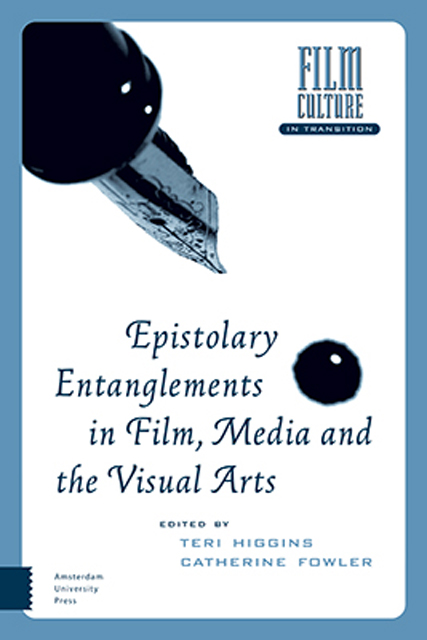Book contents
- Frontmatter
- Table of Contents
- Acknowledgements
- Doing (Audio-Visual) Things with Words – From Epistolary Intent to Epistolary Entanglements: An Introduction
- 1 Performance and Power : The Letter as an Expression of Masculinity in Game of Thrones
- 2 ‘My dearest little girl, I just got your letter and I hope that you will continue to write to me often’: Epistolary Listening in News from Home (Chantal Akerman, 1976)
- 3 Dead Letters: Epistolary Hauntology and the Speed of Light in Personal Shopper (Olivier Assayas, 2016)
- 4 Attention to Detail: Epistolary Forms in New Melodrama
- 5 The Spiritual Intimacies of The Red Hand Files: How Long Will I Be Alone?
- 6 Video Authenticity and Epistolary Self-Expression in Letter to America (Kira Muratova, 1999)
- 7 Epistolary Affect and Romance Scams: Letter from an Unknown Woman
- 8 Delivering Posthumous Messages : Katherine Mansfield and Letters in the Literary Biopic Leave All Fair (John Reid, 1985)
- 9 The Interactive Letter : Co-Authorship and Interactive Media in Emily Short’s First Draft of the Revolution
- 10 Epistolary Distance and Reciprocity in José Luis Guerín and Jonas Mekas’s Filmed Correspondences
- 11 Instagram and the Diary : The Case of Amalia Ulman’s Excellences & Perfections (2014)
- 12 Civil War Epistolary and the Hollywood War Film
- 13 Epistolarity and Decolonial Aesthetics in Carola Grahn’s Look Who’s Talking (2016)
- 14 Epistolary Relays in Fatih Akin’s Auf der anderen Seite (On the Other Side/On the Edge of Heaven) (2007)
- Index
6 - Video Authenticity and Epistolary Self-Expression in Letter to America (Kira Muratova, 1999)
Published online by Cambridge University Press: 20 June 2023
- Frontmatter
- Table of Contents
- Acknowledgements
- Doing (Audio-Visual) Things with Words – From Epistolary Intent to Epistolary Entanglements: An Introduction
- 1 Performance and Power : The Letter as an Expression of Masculinity in Game of Thrones
- 2 ‘My dearest little girl, I just got your letter and I hope that you will continue to write to me often’: Epistolary Listening in News from Home (Chantal Akerman, 1976)
- 3 Dead Letters: Epistolary Hauntology and the Speed of Light in Personal Shopper (Olivier Assayas, 2016)
- 4 Attention to Detail: Epistolary Forms in New Melodrama
- 5 The Spiritual Intimacies of The Red Hand Files: How Long Will I Be Alone?
- 6 Video Authenticity and Epistolary Self-Expression in Letter to America (Kira Muratova, 1999)
- 7 Epistolary Affect and Romance Scams: Letter from an Unknown Woman
- 8 Delivering Posthumous Messages : Katherine Mansfield and Letters in the Literary Biopic Leave All Fair (John Reid, 1985)
- 9 The Interactive Letter : Co-Authorship and Interactive Media in Emily Short’s First Draft of the Revolution
- 10 Epistolary Distance and Reciprocity in José Luis Guerín and Jonas Mekas’s Filmed Correspondences
- 11 Instagram and the Diary : The Case of Amalia Ulman’s Excellences & Perfections (2014)
- 12 Civil War Epistolary and the Hollywood War Film
- 13 Epistolarity and Decolonial Aesthetics in Carola Grahn’s Look Who’s Talking (2016)
- 14 Epistolary Relays in Fatih Akin’s Auf der anderen Seite (On the Other Side/On the Edge of Heaven) (2007)
- Index
Summary
Abstract
This chapter presents a brief overview of Kira Muratova's cinematic approach to epistolary communication from 1967 to 1999, focusing in particular on how letters serve as the ground for a wider inquiry into issues of self-presentation, performativity, and authenticity. This contextualization prepares the ground for an analysis of the director's foray into the video letter in her 1999 short Letter to America. Below, I argue that Letter to America's greatest contribution to Muratova's exploration of epistolary forms is its capacity to align a worry about the letter as self-performance with a metafictional concern with cinematic truth.
Keywords: Kira Muratova; Letter to America; video authenticity; video letter; cinematic epistolarity
In the opening to his article ‘History, Power, and Incomplete Epistolarity in Post-Soviet Cinema’, scholar Seth Graham claims that one of the fundamental features of epistolarity as presented in the cinema of the Soviet and post-Soviet spaces is the absence of an obligatory reciprocity between letter-writer and letter-recipient. If, traditionally, the epistolary exchange between self and other is sustained by the subsequent alternation of first- and second-person positions among interlocutors, in Soviet and post-Soviet cinema, Graham argues, this precondition is problematized, challenged, and even rejected. Such films, he claims, not only feature letters that do not fit within orthodox descriptions of the medium – ‘open letters, forged letters, letters to dead or unreal addressees’ etc. – but also have their ontological status modified through the interference of specifically cinematic techniques. To film a letter is to make decisions about how to present it, to alter it, and hence to shape both its contents and the projected self-image of the parties involved.
While Graham's thesis was almost certainly not designed with the cinema of Kira Muratova specifically in mind – prominent in his discussion are analyses of Kalatozov's Letter Never Sent (1960) as well as post-Soviet works from outside the Russian Federation and Ukraine – her work supports his account. Muratova's cinema features not only a plethora of epistolary forms presented in various formats – read out loud, dictated, shown on screen – but her work also importantly questions the primacy of the connection between the letter and the written word.
- Type
- Chapter
- Information
- Epistolary Entanglements in Film, Media and the Visual Arts , pp. 125 - 138Publisher: Amsterdam University PressPrint publication year: 2023

